The National Gallery’s exhibition Van Gogh: Poets & Lovers (until 19 January 2025) has opened to five-star reviews. Here we discover ten surprises about individual paintings on loan from around the world. Enjoy the stories—and then book a ticket to see the art, before the show sells out.
A self-portrait once hung in Regent’s Park

Van Gogh’s Self-portrait (September 1889) and the painting hanging in the ante-room of Winfield House, London (1959)
Left: National Gallery of Art, Washington, DC (collection of Mr and Mrs John Hay Whitney, 1998). Right: Associated Press / Alamy Stock Photo
This famed Self-portrait (September 1889) once hung in Winfield House, the official residence of the American ambassador. Built in 1936, the mansion is set in a secluded spot in Regent’s Park and boasts London’s largest private garden after that of Buckingham Palace.
As this little-known photograph shows, the Van Gogh hung for a few years above the mantelpiece in the ante-room, which leads to the dining room. John Hay Whitney, the ambassador to the UK in 1957-61, had it in his personal collection. He died in 1982 and in 1998 his widow Betsy bequeathed the self-portrait to the National Gallery of Art in Washington, DC. Now it is back in London again, in the current exhibition.
Painted on a dish towel
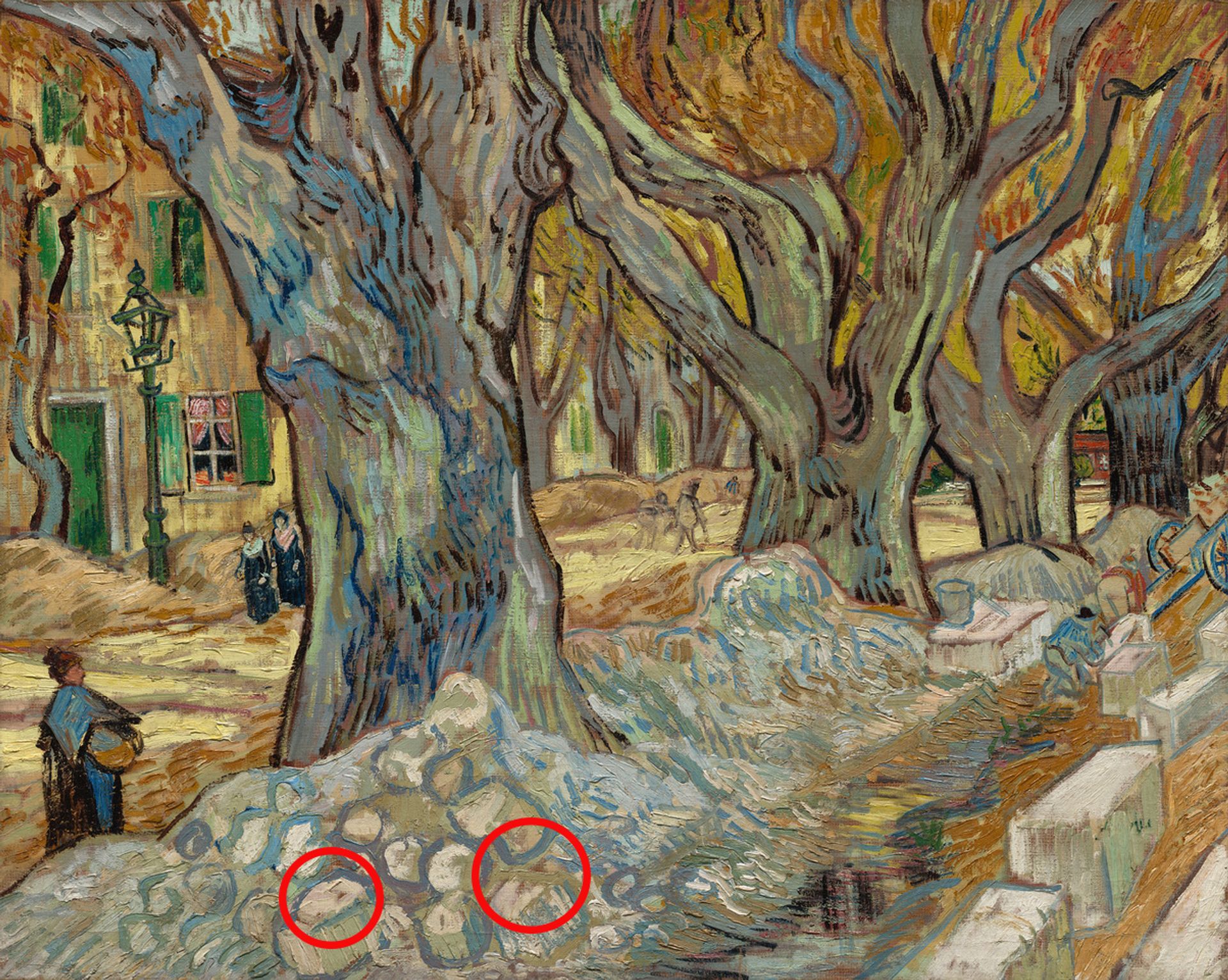
Van Gogh’s The large Plane Trees (Road Menders at Saint-Rémy) (December 1889), with several red marks on the torchon fabric indicated
Cleveland Museum of Art (Hanna Fund, 1947.209
When Van Gogh ran out of canvas he would sometimes use a fabric known in French as torchon, which is widely employed for tea towels. It often has red lines or patterns.
On 26 November 1889 Vincent had complained to his brother Theo that he was “completely at the end of my canvas”. A few days later he made The large Plane Trees on torchon. Some areas were thinly painted and red diamond shapes can just be made out among the stones in the foreground, to the left of centre.
Casino boss Steve Wynn’s Van Gogh

Van Gogh’s The Trinquetaille Bridge (June 1888)
Wynn Fine Art
Steve Wynn’s name is revealed in the London exhibition as the owner of The Trinquetaille Bridge (June 1888). He bought it at Christie’s in 2021, paying $39m, and it is owned by his Las Vegas-based company, Wynn Fine Art. The firm describes Wynn as “an American entrepreneur, philanthropist, art collector and visionary credited with transforming the Las Vegas Strip into an international destination”. He retired from the hotel business in 2018.
Why a stark white frame?
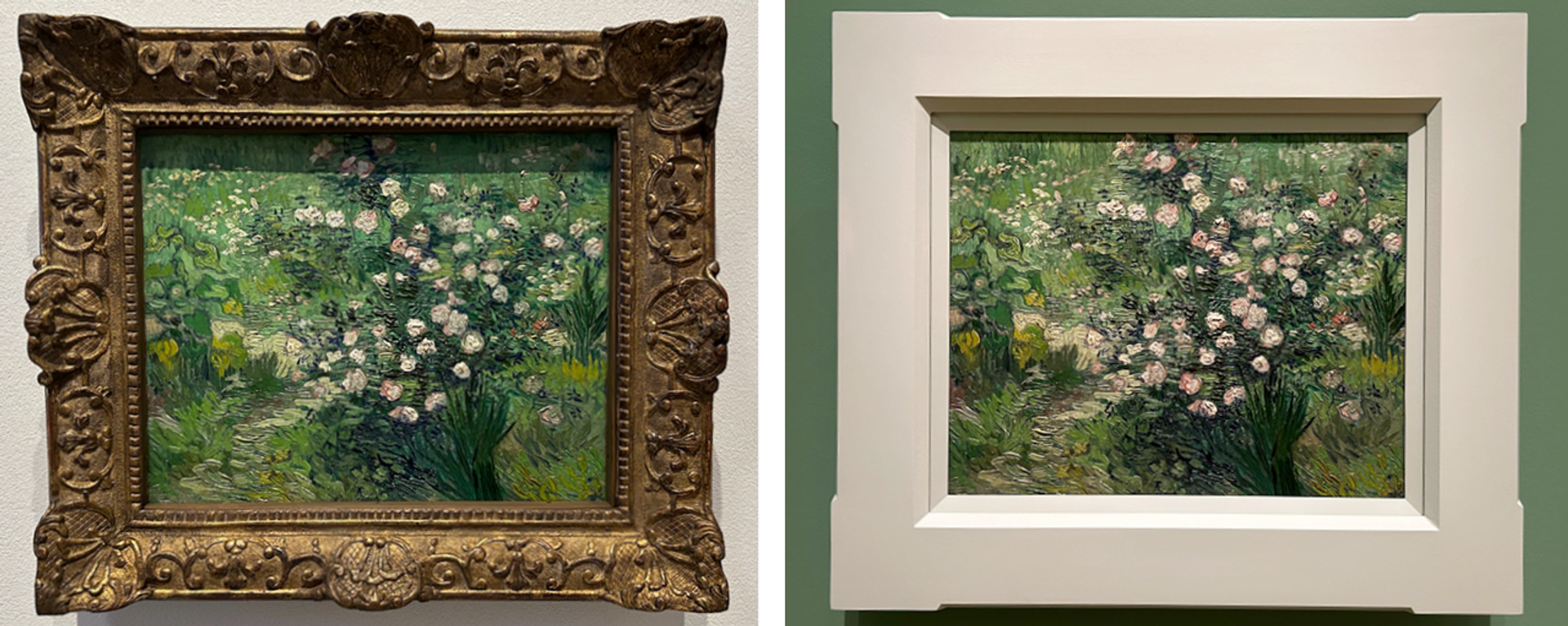
Van Gogh’s Roses (April 1889) in its gilded frame and its current replica Gachet frame
National Museum of Western Art (photographs by The Art Newspaper)
This one was a surprise, even for the exhibition’s curators. Tokyo’s National Museum of Western Art decided to reframe their Roses (April 1889), taking it out of its traditional, gilded frame. What few visitors to the London show will realise is that the new white frame is a replica of one that may well have been on the painting in 1890, soon after the work had been given to Dr Paul Gachet, who cared for the artist in Auvers-sur-Oise.
Gachet owned quite number of paintings given to him by the Van Gogh brothers, for which he designed his own frames. A few years ago some empty frames were discovered, abandoned with a neighbour of the doctor’s son. Their existence was first revealed a year ago, in an exhibition at the Musée d’Orsay in Paris.
Roses had been owned by the doctor, sold off by his son in 1923, then bought by a Japanese collector, eventually ending up in the Tokyo museum. Earlier this year curators at the National Museum of Western Art were inspired to create a replica Gachet frame. Which frame works best for Roses? The white is perhaps slightly bright, but to my mind simple is still best.
The world’s third richest person
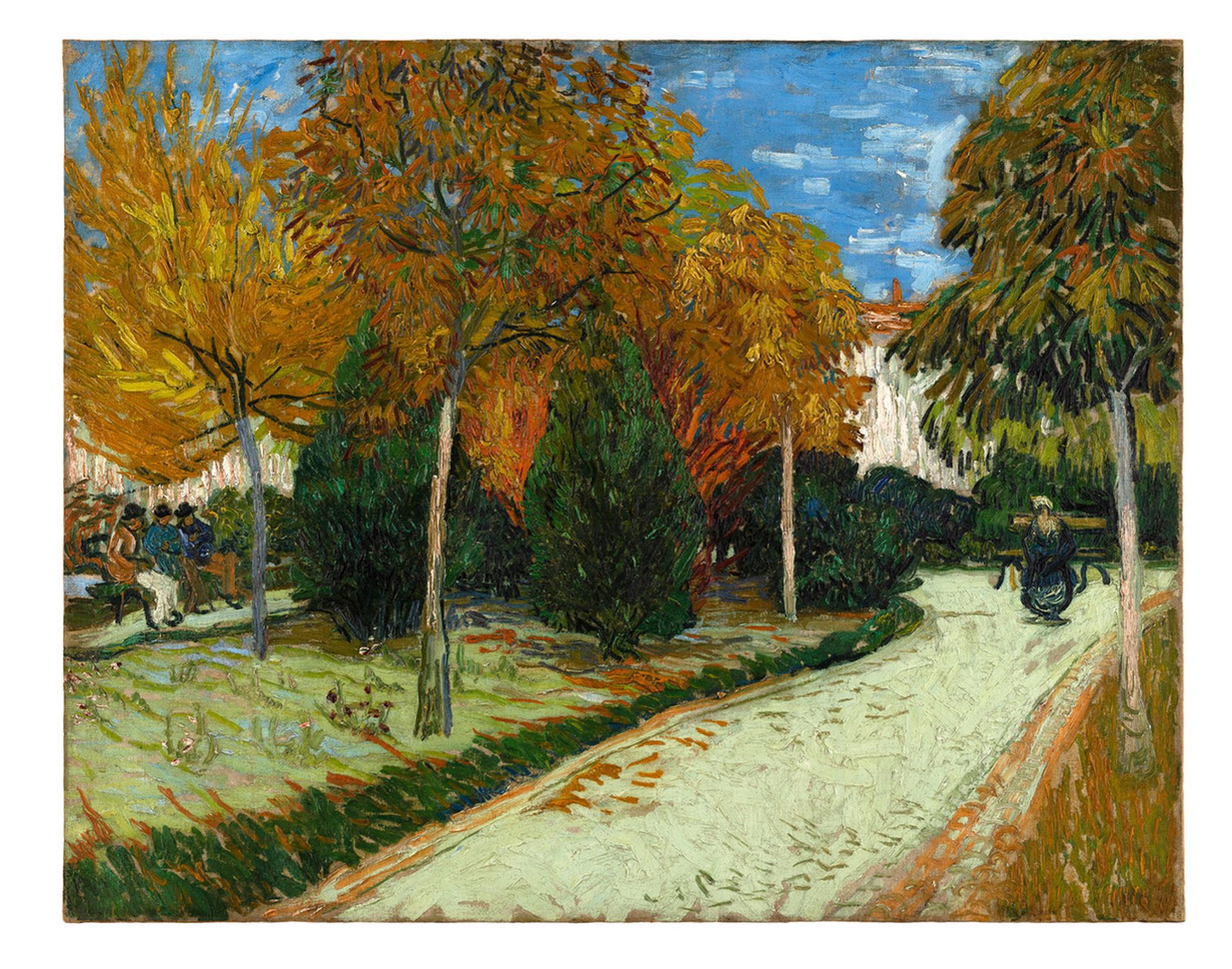
The Public Garden, Arles (October 1888)
Fondation Louis Vuitton, Paris (Primae/Louis Bourjac)
A foundation set up by the successful businessman, philanthropist and collector Bernard Arnault owns The Public Garden, Arles (October 1888). The Fondation Louis Vuitton’s funding comes from Arnault’s Paris-based luxury goods company, Louis Vuitton. In the art world it is best known for its striking exhibition centre in a Frank Gehry-designed 2014 building in the Bois de Boulogne.
The Public Garden, Arles was lent by the foundation to Van Gogh exhibitions in Paris (2014) and New York (2023), but anonymously. Now the secret is out, with the Vuitton credit on the National Gallery’s wall.
Sunflowers reframed to recreate a dream

Van Gogh’s Sunflowers: Philadelphia’s blue version, in its original, gilded frame and in the new simpler frame in the National Gallery exhibition
Philadelphia Museum of Art (London presentation photographed by The Art Newspaper)

Triptych presentation of the London and Philadelphia Sunflowers (August 1888 and January 1889), surrounding La Berceuse (The Lullaby) (January 1889)
The Art Newspaper
The National Gallery’s greatest coup is to have borrowed one of the two versions of Van Gogh’s Sunflowers on a blue background. This makes it possible to recreate the artist’s idea to present a triptych, with both the yellow and blue Sunflowers on each side of La Berceuse (The Lullaby) (January 1889, Museum of Fine Arts, Boston).
The problem for the London curators was that the Philadelphia Museum of Art’s blue Sunflowers was in an ornate gilded frame, whereas the National Gallery’s yellow one is in a simpler frame made in 17th century Italy. They would have looked awkward together.
The Philadelphia museum therefore made an unusual decision to temporarily reframe their masterpiece. They created one similar to that in the National Gallery’s collection, although deliberately not an exact copy. This creates a balanced effect for the triptych.
The interesting question is what will happen when the Sunflowers is returned to Philadelphia at the end of January. Will it go back into its gilded frame—or stay in its London frame? Once again, I personally feel the simpler frame gives more power to the Van Gogh masterpiece.
A grasshopper got stuck
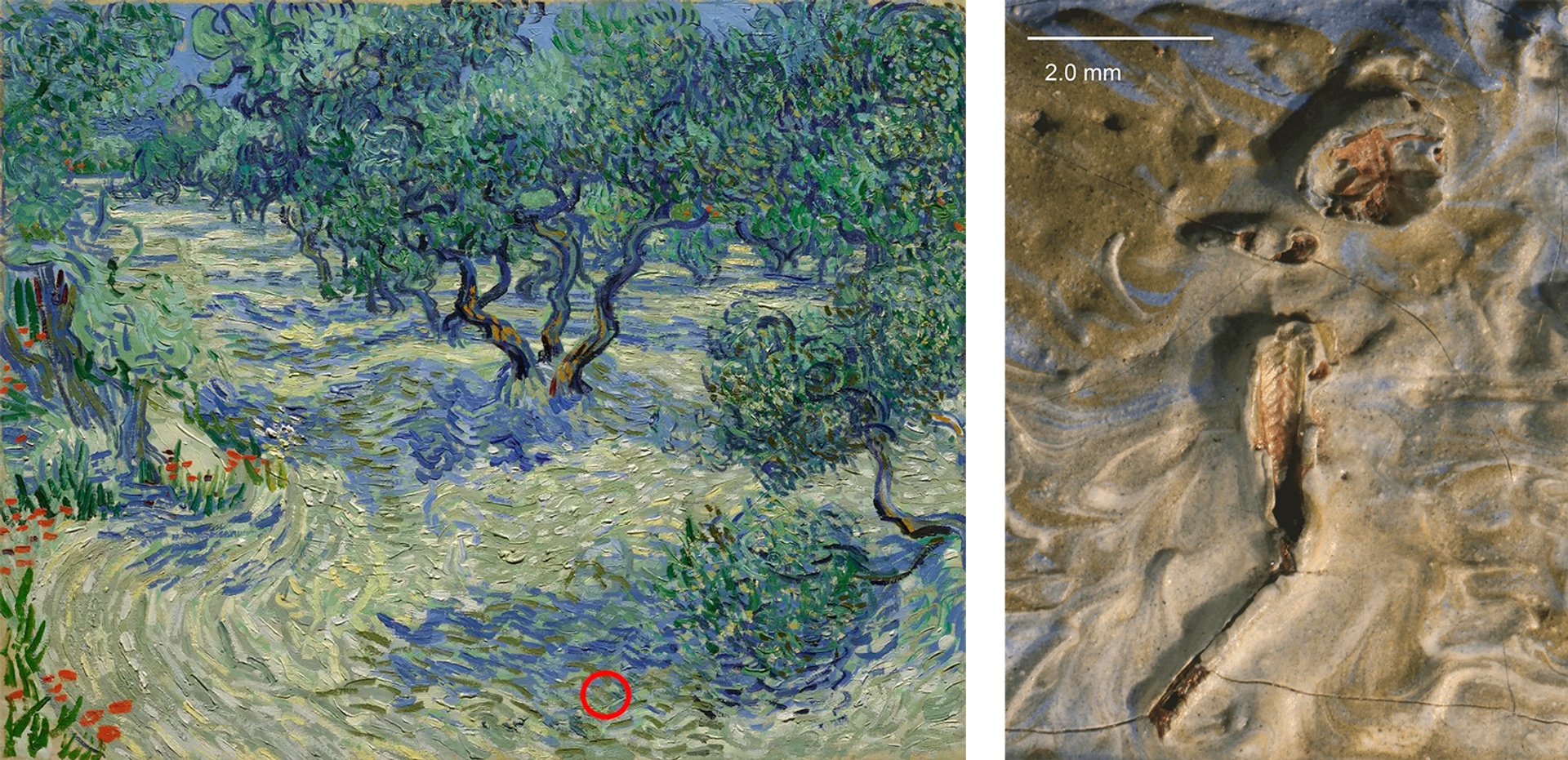
Van Gogh’s Olive Trees (June-September 1889), with the spot where the grasshopper got stuck circled in red, and a greatly enlarged image of the insect’s head and hind leg
Nelson-Atkins Museum of Art, Kansas City, Missouri
A recent discovery by conservators at the Nelson-Atkins Museum of Art in Missouri confirms that its Olive Trees was painted outside, not in Van Gogh’s studio in the asylum at Saint-Rémy-de-Provence. Parts of a grasshopper were found, which must have been blown onto Van Gogh’s wet paint. There was no disturbance to the paint, which would have occurred if a live insect had got stuck, so presumably it must have been dead on arrival.
The grasshopper’s remains are not visible to the naked eye, but Olive Trees is a magnificent painting, so enjoy its dramatically swirling brushwork.
The Lover with the wrong emblem

Van Gogh’s The Lover (Portrait of Lieutenant Milliet) (September 1888) and sketch in his letter to Theo of 29 September 1888
Kröller-Müller Museum, Otterlo and Van Gogh Museum, Amsterdam (Vincent van Gogh Foundation)
The Lover, one of the pair of portraits which gave the National Gallery’s exhibition its subtitle, has lieutenant Paul-Eugène Milliet’s regimental emblem the wrong way around. As the exhibition catalogue explains, the crescent moon should be pointing to the right, not the left. Vincent drew it correctly in a letter to his bother Theo.
Why paint it wrongly? It could have been a mistake, although that could hardly have happened if Milliet had been present when it was done. More likely, it was artistic licence, to create a more balanced composition. But the mistake does suggest that the emblem was added shortly after the sitting with Milliet. Had he known, the lieutenant would surely have regarded the distortion of his regimental symbol as an insult.
Let’s do a swap (for a few months)

Jean-Auguste-Dominique Ingres’ Madame Moitessier (1856) and Van Gogh’s Portrait of a Peasant (Patience Escalier) (August 1888)
Norton Simon Museum, Pasadena and National Gallery, London
Most exhibition visitors have little idea how loans of important paintings are negotiated. Sometimes the other gallery offers to lend an important painting to the borrowing gallery in what is effectively an exchange, but normally this is done discreetly and sometimes informally.
Unusually, the Norton Simon Museum in California requested that their arrangement should be out in the open. In the only prominent wall caption in the London exhibition, the deal is spelt out: the “extraordinary loan” of Portrait of a Peasant is in “exchange” for the National Gallery’s loan of Jean-Auguste-Dominique Ingres’ Madame Moitessier (1856) to a Norton Simon exhibition two years ago.
A Norton Simon spokesperson told The Art Newspaper that when it comes to masterpieces, the museum will “lend only in the context of these partnerships”.
Seeing the images of the Ingres and the Van Gogh together emphasises how portraiture developed in just over 30 years—and how revolutionary was the Dutchman’s art. Portrait of a Peasant is one of the finest works in the London exhibition and has only been shown once in Europe since the 1930s. Don’t miss it.
A revolutionary white border for a white wall
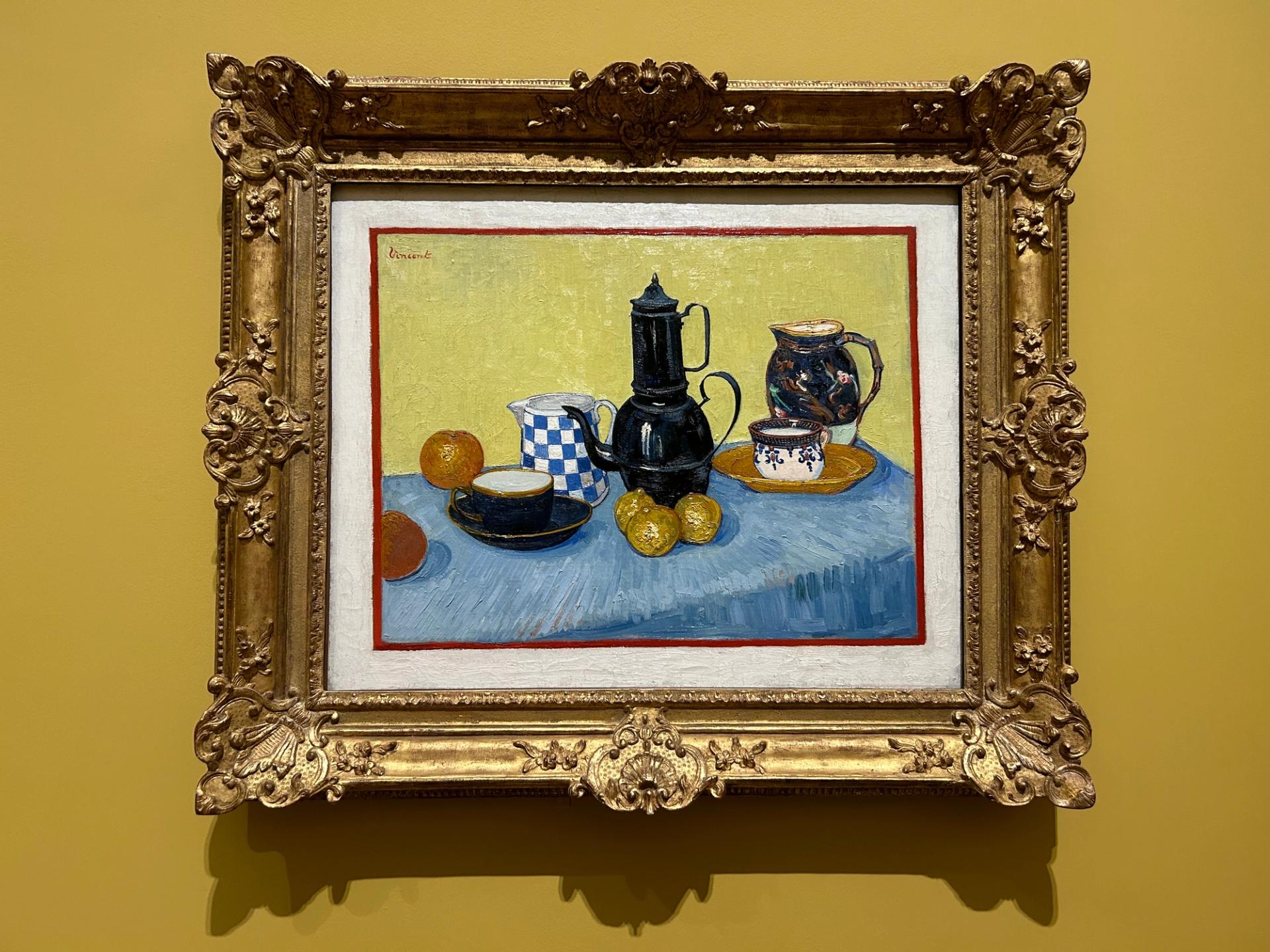
Van Gogh’s Still life with Coffee Pot (May 1888)
Basil & Elise Goulandris Foundation, Athens
Still life with Coffee Pot (May 1888) is most unusual, in that Van Gogh painted a thin red border onto his canvas and then added a wider white border on the canvas—essentially “framing” the picture. Owned by the Goulandris foundation in Athens, it is now conventionally shown in an ornate gilded frame. In the London exhibition it hangs on an ochre wall.
The effect of the painting in Van Gogh’s time would have been quite different. He would have presumably hung it in Arles, unframed, as he did most of his pictures. It would have been on a white wall (although known as the Yellow House, this colour referred to the exterior, and its interior was whitewashed). The red border in Still life with Coffee Pot would have appeared as a visual frame, while the white surround of the canvas hanging on the whitewash would have made the picture almost appear to float on the wall.
I have always imagined that Still life with Coffee Pot hung in the kitchen of the Yellow House. The objects in the still life would have been close at hand: his newly acquired enamel coffee pot, a distinctive milk jug with a chequerboard pattern, a large majolica jug, cups and saucers, two oranges and three lemons.
Seeing the picture in the National Gallery’s show gives us a delightful insight into domestic life in the Yellow House, where he painted his greatest works.






